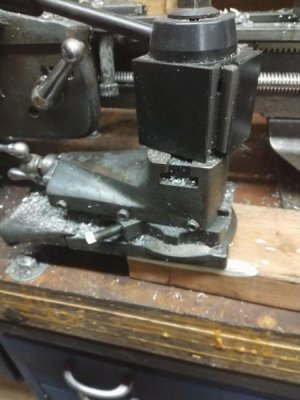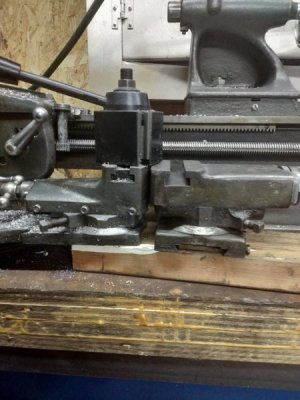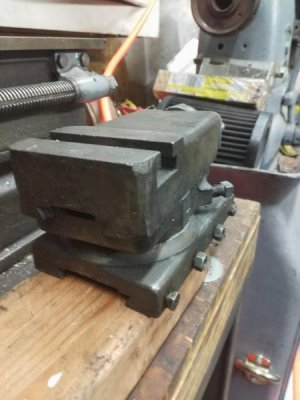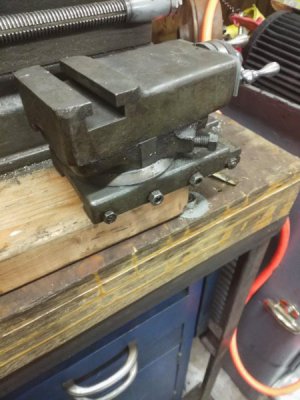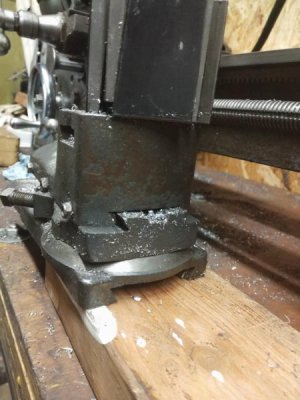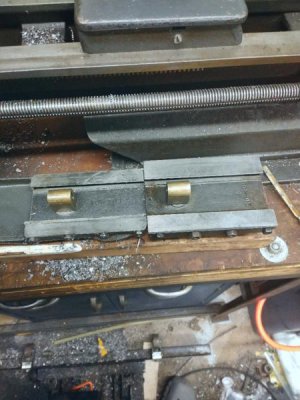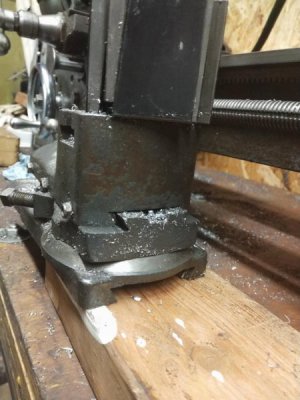Hopefully this thread will help out my fellow Craftsman 12 lathe owners in improving the compound stiffness on their Atlas 12 lathes. I got my Atlas years ago from my father's best friend. He had owned the lathe from a purchase of a farm that he subsequently owned for 5 years. In the barn there was a nice condition Atlas 12 lathe that was Craftsman branded model 101-07403. It was in great condition complete with chuck, tailstock and some tooling. His friend wanted to have his son learn how to work on the lathe and my guess is in trying to figure out how to use it he crashed the lathe and tore the gearing for the compound feed in the apron. After selling the farm he took the lathe with him. While working with him my dad learned he had a lathe and asked if he wanted to get rid of it. A couple hundred buck later I had my first machine too, a Craftsman lathe. I learned everything that i know from this lathe and over the years collected up another craftsman 12 lathe with a gearbox, steady rest, follower rests, a 4 jaw chuck, milling attachment and more. I bought parts on garage sales, from motorcycle shops, flea market and everywhere in between. I shortly after getting the lathe bought a AXA QCTP for it, I actually never used the lantern post it came with. Over the years of cutting my compound seems to have developed much more flex. the tool post is very stiff but sometimes I can see the compound flex. Many friends have laughed at me for owning the Craftsman calling it a noodle. Some of them own Logan or south bends. A few years back I had a chance to buy a Sheldon 13. Not knowing much about lathes I bought it from one of my friends acquaintances. In the process of cleaning it up I leaned that the carriage was pretty well worn and some gears were stripped. I decided to repair it and start working on it. Well that has taken a back seat to other projects and through all those there has been my trusty Craftsman lathe. Last year I procured a Elgin 9 Split bed lathe which needed a compound but had chuck tailstock collets etc. Wow that is one hell of a machine. It weights 1300 pounds and has a CAST IRON cabinet, to say its stiff when you cut on it is an understatement. I am so surprised how cheap you can buy split bed lathes and how few hobbyists even consider them. Just this last week there was a Hardinge split bed in Waukegan IL no compound tailstock and it didn't sell for $49. Yes you read that right $49 dollars. the scrap in that machine is worth more. I bought the Elgin to make super precision parts for my machines and tools that don't need threading. I also bought it because I want a CNC lathe. I just last wseek bought iron to make a CNC compound for this lathe. When you want cnc you mount the CNC compound and when you dont just put the manual one on. It may not be able to cut screws but it could machine spindles to lathes its so accurate. Well in all this I was using my Craftsman lathe in the mean time. I had a crash and stripped two gears in the Quick change gear box but two auctions later wallah it was fixed. Yet when I cut 5 inch steel adapter for car disk brakes man was that compound flexing. I had bought a turret tailstock for my Elgin from a regional guy on Ebay. I looked through his past auctions and saw he sold a production compound for a 12 inch Atlas. I though to myself if I could only get my hands on one I could eliminate some of the flex. Alas those are not cheap or easy to find. One day I got to visit a guy who had a Atlas mark 2 lathe from the sixties. I looked at the compound and though wow that is really overbuild compared to mine. I went home and thought man could I put that on my lathe. I emailed Clausing and the guy said he would look into it for me. He emailed back two days lathe and said it would mount but the base that the compound was mounted (to the one with degrees on it ) was not wide enough and would not give enough support. I should have left it there but I though what if I got the base too. Well I am glad to inform you guys I bought the parts on ebay and yes the compound does mount by itself but the guy was right the contact is less. Well the I took the compound base and put in on the dove tail and the screw and base fit perfectly well .The gib is plastic though so I may reuse the steel one. The height turns out to be identical. I may have just solved some of my flex issue. The compound base is wider than dovetails though. but I am going to leave it. I could machine some of the sides but why make it less stiff. Here are some comparison pics I took quickly hopefully someone can benefit from my find. I will never get rid of my Craftsman, as long as you treat it well it just keeps going. Parts are available around the clock and those pesky accessories are not only readily available but you can pick and choose. Neither of my other machines have that possibility. I have been looking for a carriage for the Sheldon for 3 years now with very little luck Out of interest I wondered what the Craftsman cost in todays money all those years ago. In 1951 a well tooled Craftsman was $259 that is about $4400 dollars in today's money. Even scarier was the Elgin it cost $1350 in 1931 that is about $22,400 in today's money. Man no wonder its so nice. I figure only a machine shop could have afforded that and yet today a lowly home shop machinist can own such a piece of machinery. Cost wise it was on par with a smal cnc machine today.
